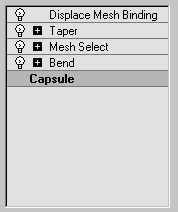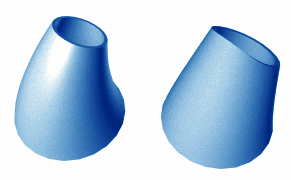The modifier stack and its editing dialog are the keys to managing all aspects of modification. You use these tools to:
- Find a particular modifier and adjust its parameters.
- View and manipulate the sequence of modifiers.
- Copy, cut, and paste modifiers between objects, or sets of objects.
- Deactivate the effect of a modifier in the stack, the viewport display, or both.
- Select a modifier’s components, such as gizmo or center.
- Delete modifiers.
Examining the Modifier Stack
The modifier stack (or "stack" for short) is a list on the Modify panel. It contains the accumulated history of a selected object and any modifiers you have applied to it.
Internally, 3ds Max "evaluates" an object beginning at the bottom of the stack and applies changes to the object by moving sequentially to the top of the stack. You should therefore "read" the stack from bottom up to follow the sequence used by 3ds Max in displaying or rendering the final object.
Here is an example of stack entries for a capsule object (an extended primitive):

- At the bottom of the stack, the first entry always lists the object type (in this case, Capsule). You click this entry to display the original object creation parameters so you can adjust them. If you haven’t applied any modifiers yet, this is the only entry in the stack.
- Object-space modifiers appear above the object type. You click a modifier entry to display the modifier’s parameters so you can adjust them, or to delete the modifier.
 Modifiers are preceded by a plus or minus icon if they have sub-object (or sub-modifier) levels. See Using the Stack at Sub-Object Level.
Modifiers are preceded by a plus or minus icon if they have sub-object (or sub-modifier) levels. See Using the Stack at Sub-Object Level. - At the top of the stack are world-space modifiers and space warps bound to the object. (In the illustration, Displace Mesh is a world-space modifier.) These always appear at the top, and are described as "bindings."
Basics of Using the Stack
With the stack feature, no modification has to be permanent. By clicking an entry in the stack, you can go back to the point where you made that modification. You can then rework your decisions, temporarily turn off the modifier, or discard the modifier entirely by deleting it. You can also insert a new modifier in the stack at that point. The changes you make ripple upward through the stack, changing the current state of the object.
Adding Multiple Modifiers
You can apply any number of modifiers to an object, including repeated applications of the same modifier. As you start applying object modifiers to an object, the modifiers "stack up" in the order they’re applied. The first modifier appears just above the object type at the bottom of the stack.
- 3ds Max inserts a new modifier in the stack just above the current selection, but always in the proper location. If you try to insert a world-space modifier between two object-space modifiers, 3ds Max automatically places it at the top of the stack.
- If you select the object type on the stack and apply a new object-space modifier, it appears just above the object type and becomes the first modifier evaluated.
Effect of Stack Sequence
3ds Max applies modifiers in their stack order (beginning at the bottom and carrying the cumulative change upward), so a modifier's location in the stack can be critical.
The following figure shows the difference between the objects based entirely on a reversal in the stack order of two modifiers. On the left-hand tube, a Taper modifier is applied before a Bend modifier, and on the right-hand tube, the Bend is applied first.

Results of reversing stack order of two modifiers
Using the Buttons
These buttons, found just below the modifier stack, help you manage the stack:
 Pin Stack
Pin Stack-
Locks the stack and all Modify panel controls to the selected object’s stack. You can continue to edit the object even if you select a different object in the viewports.
 Show End Result
Show End Result-
When on, shows the effect of the entire stack on the selected object. When off, shows the effect of the stack only up to the currently highlighted modifier.
 Make Unique
Make Unique-
Makes an instanced object unique, or an instanced modifier unique to a selected object. See details in Editing the Stack. This option is also available from the Modifier Stack right-click menu.
 Remove Modifier
Remove Modifier-
Deletes the current modifier from the stack, eliminating all changes caused by that modifier.
 Configure Modifier Sets
Configure Modifier Sets-
Click to display a pop-up menu that lets you configure how to display and choose modifiers on the Modify panel.